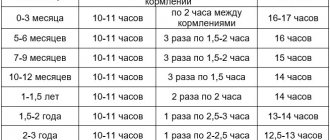How can you tell if your newborn is hungry? Regardless of whether the baby is breastfed or bottle-fed, there is a whole set of signals that the child gives before the desire to snack.
The parents' task is to correctly and, most importantly, recognize these signs in time - until the baby finally gets hungry and starts crying. After all, then it will be much more difficult to feed him.
Symptoms of malnutrition in infants
With proper attachment to the breast and proper latching of the nipple by the baby, postpartum lactation is established immediately.
The main signs by which you can determine that there is not enough milk:
- The newborn does not gain weight well or even loses valuable grams. In this case, the pediatrician prescribes frequent weighing of the child. Normally, every month it should add up to 500 g.
- When breastfeeding, the baby behaves restlessly and is nervous. He either drops the breast, then greedily begins to suck it again. In between sucking, crying and screaming appear. On the contrary, if there is enough milk, then the child himself stops eating, while he is happy and smiling.
- Absence of swallowing movements or their reduction. When the baby receives enough milk, swallowing occurs after about four sucking movements.
- After the last feeding, little time passes, and the baby again looks for the breast and asks to eat. Normally, a baby does not need milk for about three hours.
- Changes in stool (its color becomes greenish, constipation may occur), the number of urinations decreases (less than 10 times). Urine becomes dark in color.
- The child stops being active and asks to be held.
- Short, restless sleep.
- The baby may suck a finger or a corner of a blanket. At the same time he smacks his lips loudly.
- Signs of dehydration may appear. When there is no milk at all, the baby experiences a lack of fluid (breast milk contains a lot of water).
- There is no belching after feeding.
What are the reasons for not having enough breast milk?
It is easier to understand that a baby is not eating enough. But it’s harder to find out why mom doesn’t have enough milk. Only a comprehensive study of the problem will allow us to clarify the true cause. The main factors that cause milk loss include: the mother’s environment, her internal state, disorders or diseases associated with the child himself.
It could be:
- Lack of support from family members, conflicts and stressful situations.
- Lack of rest. The consequence is fatigue and tiredness. Perhaps there is no organized place for feeding the baby.
- Improper diet (lack of vitamins and minerals, proteins, fats and carbohydrates). Eating spicy, salty foods leads to a change in the taste of milk, and the baby may not latch on to the breast for this reason.
- Cracks, wounds on the nipples.
- Anatomical features of the structure of the nipples (flat or inverted).
- Incorrect attachment to the breast, frequent changes when feeding from one breast to the other.
Signs that malnutrition problems relate to the developmental characteristics and condition of the child’s body.
- Problems with the nose. A runny nose, swelling, and nasal congestion do not allow you to breathe freely while sucking.
- Injuries and inflammatory diseases of the oral cavity.
- Uncomfortable position of the child during feeding.
- Endocrine diseases.
- Additional pacifier sucking between feedings.
How to fix the problem
If a problem arises, then the mother has a question: what to do if the baby does not get enough breast milk? When the problem has been identified, the issue can be resolved more easily. Most often, a number of simple measures are enough, and breast milk is restored.
- Regular feeding of the mother with high-quality and healthy products. There should be three hot dishes daily (porridge, pasta, meat).
- Well-established drinking regime. It is useful to drink during feeding (tea with milk, jelly, compote).
- Frequent walks in the fresh air.
- When the baby is sleeping, the woman herself should rest. Restoring milk supply is much more important than household chores.
- The breastfeeding technique must be correct.
- Feed your baby not by the hour, but on demand. Night feedings are very important.
- You can supplement your baby with expressed milk.
- Breast massage will improve milk flow.
- Special feeding accessories will make this process easier. You can buy a special pillow that will allow both mother and child to relax and take the correct position.
- Eliminate conflict and stressful situations.
What about the saying, “Never wake a sleeping child?”
If a newborn sleeps for more than four hours without waking up to feed, does that mean he shouldn't be woken? Not certainly in that way.
In the first few days of babies' lives, it is best to breastfeed on demand - at least every three to four hours - this will signal the breasts that they need to produce milk.
Healthy babies will eventually develop their own feeding rhythm. During the first month, the ideal feeding ratio is at least 8-12 feedings per day. They don't necessarily have to last the same amount of time.
Each child has their own sleep and wakefulness schedule: some need to wake up at regular intervals, while others may take a nap longer during the day and then have several snacks in the evening.
How to help your child when a problem arises
If the reason is not in the mother or in the environment, you should find out if the baby has developmental disorders.
- Be examined by specialized specialists: otolaryngologist, endocrinologist, gastroenterologist. It is possible that additional examination methods will be prescribed (ultrasound of the abdominal cavity, coprogram, blood and urine tests).
- The baby should be fed with expressed milk. There is a danger here that the child will completely refuse the breast. Eating from a bottle with a nipple is much easier and faster. Additional feeding should be done from a syringe or spoon.
- If there is not enough milk or it has disappeared, then you should switch to formula. They should be prepared strictly according to the instructions found on each jar. The first portion should be made in small quantities.
- It happens that the baby quickly falls asleep during feeding. In this situation, you should wake him up.
To check how much milk your baby has sucked from the breast, you should weigh him before and after feeding. The diaper does not need to be changed, even if the baby has urinated.
In the first days after birth, the baby needs about 200 ml for the whole day. A month-old baby drinks up to 600 ml per day.
The following can hardly help in this situation: the mother drinking plenty of milk, early introduction of complementary foods, supplementary feeding with an adapted formula. All these methods are ineffective in getting a child to gain weight.
Through breast milk, a baby receives many nutrients, as well as antibodies that protect his body from diseases in the first months of life. It is very important to ensure that there is enough milk and that it does not go to waste. There is no need to hesitate to seek advice from specialists for any reason, who will suggest the right way out in the current situation.
A loving and caring mother gives herself to her baby through the main ability given to her by nature - breastfeeding. With the birth of a baby, mothers are concerned about one of the main questions: what if the child does not get enough breast milk? What to do in this case?
In the first hours after birth, a woman’s breasts may not produce enough milk, but with the right behavior, lactation will normalize already on the second or third day. The actions of a nursing woman should be guided by the needs of her child. Due to ignorance, fear, and inattention, women begin to take care of stable lactation late. To avoid this problem, you need to monitor whether your baby is getting enough breast milk.
- Hungry cry - every mother can determine by the nature of her baby’s cry what he needs;
- Low child activity and lethargy;
- A sharp reaction to the approach and smell of the mother;
- Restless sleep or lack thereof;
- Insufficient number of acts of defecation and urination. Normally, a child is able to wet up to 20 diapers per day. Stool after each feeding is also a sign that the baby is full and that milk is well absorbed;
- Thumb sucking, diaper edge sucking, tongue or lip smacking;
- Low weight gain or loss. Determined during control weighing at the pediatrician. The exception is the period of stay of the mother and child in the maternity hospital for 3-5 days, when weight loss is considered natural within 10%.
Breast milk is both food and drink for the baby. More than 80% of it consists of water. Excessive dryness of a child's skin may also be a sign that the child is not getting enough to eat.
Causes of lack of breast milk
Understanding that a baby is hungry after feeding is easier than finding the reasons for this. They are usually identified in a complex manner. Conventionally, they can be divided into general (environmental factors), behavioral (determined by the mother’s behavior), and physiological (depending on the child’s condition).
Common reasons why a child does not eat enough:
- difficult psycho-emotional situation in the family, misunderstanding, lack of support, reluctance of other family members to accept new rules of life and rebuild;
- irrational organization of the place where the child is fed and where the mother rests.
The group of behavioral factors includes:
- insufficient and unbalanced nutrition of the mother - what can a nursing mother eat (list of products);
- low physical activity, lack of fresh air;
- lack of sleep, fatigue;
- improper attachment of the baby to the breast, violation of feeding technique;
- the presence of flavor in milk due to the consumption of spices and seasonings;
- the mother’s psychological unpreparedness to breastfeed, rejection of the feeding process itself, postpartum depression, soreness, cracked nipples;
- medical indications (flat nipple).
The child’s physiology also influences the process of satiation. The baby's significant weight at birth (more than 4 kg) coupled with delayed lactation rates in the first days after birth is the main cause of malnutrition. A runny nose, oral injuries, uncomfortable body position, and colic make sucking difficult and the baby does not get enough to eat.
A very common reason that a baby cannot get enough is an excess of breast milk caused by excessive breast pumping. Hyperlactation occurs.
Human milk consists of fore and hind milk. Hind milk is fattier, more nutritious, and thicker. Foremilk replaces the baby's water. A woman’s breast produces as much milk of optimal quality as her baby needs at each age period. Pumping artificially increases milk production. By consuming a significant amount of foremilk, the child does not receive enough nutritional components, quickly absorbs it and remains hungry.
Solution
What should I do to ensure that my baby is fully fed? — Strictly follow the rules below:
- regulate nutrition - eat by the hour, at least 3-5 times a day, balance your diet: How much should you feed your child;
- drink enough fluid, incl. milk teas are suitable for stimulating lactation (how to increase breast milk lactation);
- exclude foods that affect the taste of milk - what a nursing mother should not eat, and bad habits of mothers;
- walk in green areas away from roads;
- get enough sleep and rest whenever possible;
- involve loved ones to help care for the child;
- learn the correct technique for putting a baby to the breast - how to put a baby to the breast correctly;
- be sure to feed at night;
- adhere to the feeding regime, but do not deny the child milk on demand;
- If necessary, supplement the baby with expressed milk from a bottle, spoon, pipette, avoiding pacifiers outside of feedings;
- take care of breast hygiene - wash with warm water, lubricate cracks with special creams, rinse with chamomile decoction or furatsilin;
- do self-massage of the chest.
- read the article: advice for nursing mothers
Techniques such as using a special feeding pillow will help make the feeding process much easier for mother and baby. The pillow allows you to correctly position the baby at the breast and relieve tension from the mother’s back. A comfortable place for feeding, a comfortable chair, a quiet room, the absence of loud annoying sounds and strangers will create a positive atmosphere for mother and baby. A calm, rested mother means a well-fed baby.
How to tell if your baby is getting enough milk
» Infant
How can you tell if your baby is full?
If you are unsure whether your child has eaten enough, watch his fists, wrists and arms. When a newborn is ready to feed, they will often have their fists clenched tightly and their elbows bent and tucked toward their chin and mouth.
During feeding, you may notice how your baby loosens his fists and unclenches his wrists and arms.
If your baby falls asleep during a feeding but isn't fed, he'll likely tense up when you try to remove him from the breast. This will be a sure sign that the newborn is still hungry. Change the diaper before starting feeding again.
Is there enough milk?
Is the child getting enough to eat?
Is the child getting enough to eat? Is there enough milk? How to understand that a child is full? These questions arise for a young mother all the time. And no wonder. If you are breastfeeding, you may be surprised that your baby wakes up every time to feed. Therefore, it may seem that the infant is hungry all the time. The baby eats this way because the sucked milk takes several hours to digest.
Here are some signs by which you can determine whether there is enough breast milk and how to understand that the baby is full . the breasts empty and become soft after feeding; The baby's skin has good color and elasticity, it bounces back if you lightly pinch it (in a dehydrated baby, the skin will remain wrinkled for a short time); the child is growing and gaining weight (see tables for comparison); You may hear swallowing during feeding (if the room is quiet); The baby has mustard-yellow stools or frequent dark stools, 5-6 wet diapers per day (or seven to eight wet cloth diapers).
Whether you're breastfed or formula-fed, keep in mind that all babies grow at different rates and their growth rates tend to slow down at certain times. Also, if your baby was large at birth, he will not always grow as quickly to match his large size.
If your baby more or less fits into developmental norms. which undoubtedly makes you happy, see if he looks happy and healthy. If yes, most likely everything is fine. But if regular weight checks with your doctor show that your baby is not developing enough and appears weak and lethargic, then your baby may not be eating enough or his body may not be absorbing nutrients properly.
In the early days, a newborn's stool is firm and dark green due to meconium, a substance that was created in the intestines when the baby was in the womb. As soon as you start feeding and the intestines have cleared of meconium. Her stool will appear yellowish, but it may vary in color every day depending on your diet if you are breastfeeding and the amount and type of formula you feed your baby. A newborn may have 8 to 12 bowel movements per day, but if it is only one bowel movement per day, then this may also be normal. (If you are breastfeeding, your baby's stool may look softer, like diarrhea.)
Other problems in the first year of a child’s life
Interesting things on our website
Teeth cutting: how to help your baby? 3 best ways, tips and recommendations Looking at a young married couple from the outside, a person experiences
If a child chokes, what should you do in this case? First aid for a baby: step-by-step actions Emergency situations always cause panic, with
What to give to a 1 year old child? 20 best gifts for a child. At a relatively mature age, your children can say for themselves what they want.
How to raise your child educated? Many parents believe that they are Gods and know everything about raising a child. How is it not
Why a three-year-old child began to yawn frequently: reasons There are a number of problems related to children's health. This includes yawning. But before
How can you tell if your baby is getting enough breast milk? 9 signs that your baby is full
Summary of the article:
The question of how to understand that a child is full of breast milk is not difficult and every loving mother will be able to determine this. Next, we will talk about how you can determine whether your baby is full.
A loving mother does everything to breastfeed her baby at least for a moment, because her milk contains everything necessary for the full growth and development of the baby. Breastfeeding mothers wonder if her baby is getting enough to eat, and how to tell if not.
Is your baby getting enough to eat?
Often mothers are faced with a situation where, during the postpartum period, their breasts do not produce enough milk for feeding. If you establish this process, then in a couple of days lactation will return to normal. And it needs to be established immediately after the baby is born, because then it may simply be too late.
Women who are breastfeeding are familiar with having to wake up several times during the night to feed their baby. Some people think that their baby is always hungry, however, this is not the case. After all, the milk that the baby sucks takes several hours to process.
9 signs by which you can judge that your child is full:
Soft breasts; The baby's skin is elastic and has a normal color; Emptying the breast; The baby looks happy; If you pinch the skin, it will pull back; The baby urinates at least six times; Baby's stool is dark or yellow; During the feeding period, you can hear the baby eating; The baby is gaining weight. The pediatrician should tell you about this.
It must be remembered that each child develops individually and grows differently; it makes no sense to compare them. For your information, small children can poop up to twelve times a day. But the norm is for the baby to poop once a day.
Periodically you need to monitor the baby’s weight curve and behavior. If your baby is alert, wets his diapers, or has loose stools when he's awake, you have no reason to worry.
How to tell if your baby is not getting enough to eat
It’s not difficult to detect that your baby is hungry; here are the obvious signs :
- Restless sleep;
- Low activity;
- Thumb sucking, chewing your things;
- A cry that speaks of hunger;
- Smacking;
- Slight weight gain;
- Braking;
- Dry skin;
- Strong reaction to mom's approach;
To prevent your child from going hungry, you need to follow the following recommendations :
- Mom needs proper sleep and rest;
- You need to adjust your diet;
- Walk in clean air, avoiding roads;
- Knead your chest;
- Use a feeding pillow;
- Drink plenty of fluids;
- Feed the baby at night unless he asks;
- Use a nursing bra;
- Avoid foods that change the taste of milk;
- Ask loved ones for help;
- Do not refuse the baby;
- Learn how to attach your baby correctly;
- Wash your breasts;
- Drink teas that increase lactation;
- Supplement the baby with expressed milk;
- Develop a feeding regimen;
- Do not use pacifiers; it is better to replace them with a spoon or pipette;
- Lubricate cracks on the chest with creams.
Causes of milk shortage
There may be several reasons why a child remains hungry:
- A poorly chosen place for feeding, for example, if the baby has to be distracted while eating;
- Excess milk;
- Family situation, frequent scandals and screams;
- Oral diseases;
- Unbalanced diet of the mother;
- Colic. distracting the child;
- Taste of milk;
- Cracked nipples;
- Insufficient nutrition of the mother;
- Medical conditions, such as a flat nipple that is difficult for the baby to latch on to;
- Uncomfortable position;
- Mother's unpreparedness.
Breast milk is divided into two types: fore and hind. If we talk about the second type, then it is more satisfying and fattier. Foremilk acts as water. The breast provides as much fluid as the baby needs, according to age. If your baby eats foremilk, he may remain hungry.
How much to feed the baby
But every child is unique and there is no standard children's axiom indicating how much to feed a newborn.
Very often, when breastfeeding, children regain their weight, which, as a rule, they lost in the first days after birth (and this is normal), during the first two weeks after the hospital.
For other children, which is less common, it may take three to four weeks. If this happens to your child, ask your doctor to check that there is no abnormality, just a slow recovery.
But don’t rush to switch to bottle feeding, it’s better to be patient a little, because no bottles can replace mother’s milk for a baby.
How can you understand that a child is full? If your milk flows well, the baby sucks intensely at the beginning of feeding and becomes a little lethargic towards the end, and then falls asleep altogether, you have no reason to worry.
Video about baby nutrition
Next, you can watch a video about the nutrition of a newborn, what nuances and points you should pay attention to:
Signs your newborn is hungry
Infants exhibit hunger in three different states of wakefulness.
- The transitional state is the simple act of awakening.
- A state of “silent alarm” when the baby gives a barely noticeable signal that he is hungry.
- A state of “active anxiety” when the baby is already screaming and crying with all his might.
In a state of “quiet anxiety,” babies become more physically active, stretching, and moving. The child opens his mouth and begins to turn his head to one side, moves his chin, mouth and nose - as if he is looking for a nipple or bottle. The baby may also bring his hand to his mouth and suck his fingers, smack his lips and stick out his tongue.
Your baby will calm down fairly quickly if you recognize these early signs that he is hungry and start feeding.
If the signal is missed, the gap between the "silent" and "active" warnings becomes very short. If such episodes are repeated frequently, the baby may completely skip the stage of “quiet anxiety” and immediately move on to active actions, demanding attention.
During the “active anxiety” stage, the baby cries and fusses and is excited. He may also turn away from the breast or bottle. The face may also become flushed as breathing becomes faster and movements become more violent.
While crying, a baby burns a large number of calories. Tired of hysteria, the baby quickly gets tired and may even fall asleep without feeding.
If the first signs that the newborn is hungry are missed, it is recommended to calm the baby before trying to give him a bottle or breast again. It’s enough to just hug and say kind words.










